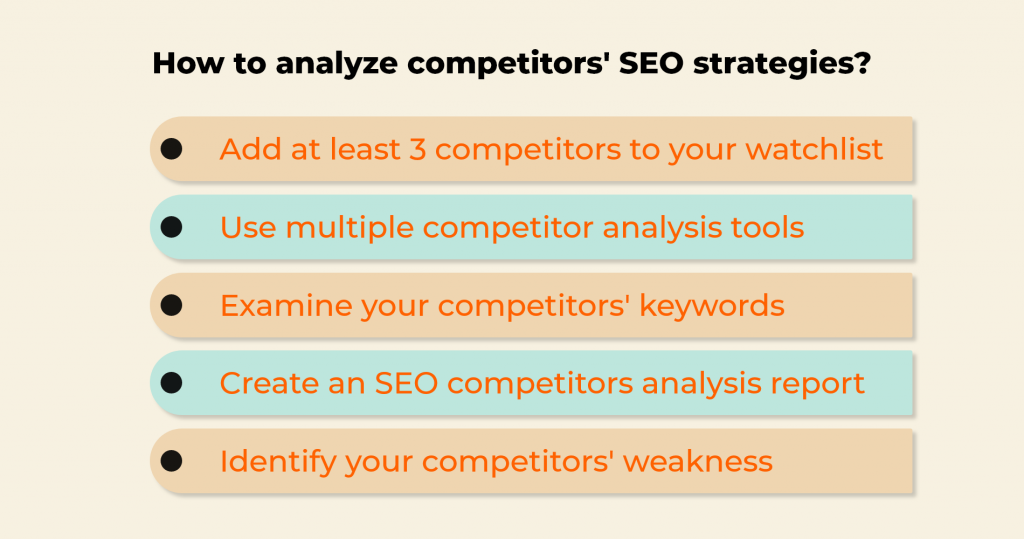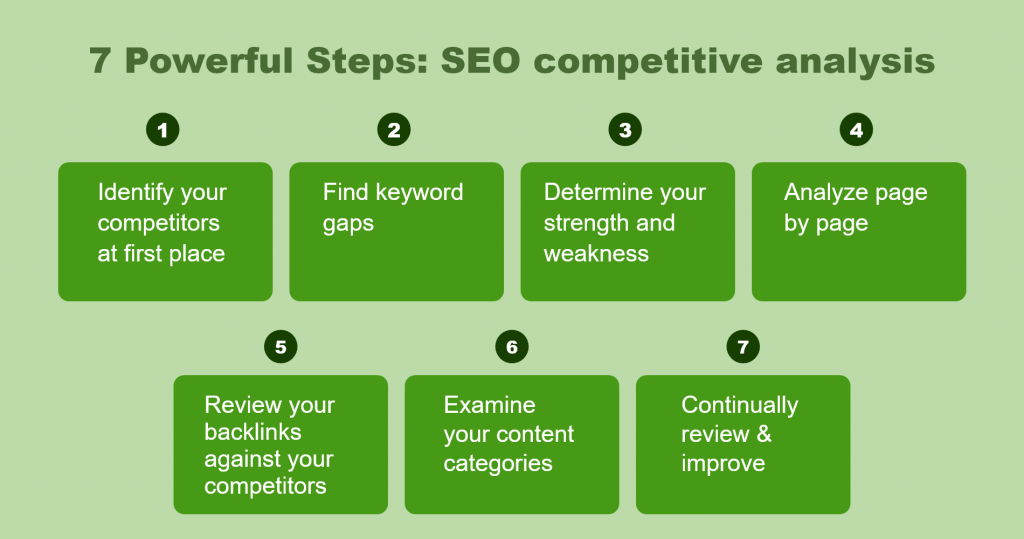
To create a successful SEO strategy, it’s vital to understand how your current plan compares to your competitors. An SEO competitive analysis can assist you in identifying areas for improvement.
SEO is a fundamental aspect of any comprehensive digital marketing strategy, it aims to increase your website’s visibility on search engines like Google, to outrank your competitors for specific keywords.
Despite the significance of SEO, many digital marketers are unaware of how their SEO strategy measures up against their competitors.
Are you wondering why your competitors are outranking you on search engines?
An SEO competitive analysis can provide you with the answers and competitive SEO insights you need to improve your own tactics.
In this article, we’ll cover the basics of competitive SEO analysis, including what it is, why it’s important, and when to conduct it. Additionally, we’ll guide you through the process of completing an SEO competitive analysis, including key steps and useful tools to assist you.
What is an SEO competitive Analysis?
An SEO competitive analysis is a method of identifying the strengths and weaknesses of your competitors’ SEO techniques and identifying opportunities for improvement in your own strategy.
By studying your competitive SEO strategies, you can gain insight into the content, keywords, backlinks, and actions that are effective or ineffective for your competition. This information can be used to measure your own SEO performance and compare it to your competitor SEO performance.
By using your competitors as a source of information for SEO rather than conducting independent research, you can gather real-time data on successful strategies and incorporate them into your own SEO planning.
Why competitor analysis is important while doing SEO?
SEO competitive analysis gives you a broader perspective on the SEO landscape in your industry. It enables you to identify the strengths and weaknesses of your competitors and to evaluate the overall market you operate in.
Even if you are currently one of the top-ranking brands in your industry, it’s still essential to conduct a competitive SEO analysis to stay ahead of the competition and provide the best possible experience for your customers.
A strong SEO presence is not a luxury, it’s a requirement for a comprehensive and successful digital marketing strategy. By consistently monitoring your competitors, you can identify opportunities to grow and fill in any gaps that your competitors have left behind.
Why my competitors are ranking higher?
The primary reason for a competitor ranking higher than you in the SERPs is that they are answering user queries more effectively and fulfilling the search intent of the keyword better.
Competitors may also have more authoritative sites linking back to them, more relevant and user-fulfilling content, or a stronger site structure.
Google evaluates the credibility of websites linking back to your site, the more credible the sites, the more trustworthy your site appears to Google, which can increase your ranking in the SERPs.
The content on your website is also crucial, as Google takes into account the depth and usefulness of the content in helping users find solutions to their problems, and the higher you can expect to rank in the SERPs.
More often than not, when competitors rank higher than you, it’s due to the type and quality of content they produce.
Other factors that can contribute to a higher ranking include having a more secure website (HTTPS), being mobile-friendly, optimizing images, having an older domain, having longer and higher-quality webpage content, using Schema markup, having strong social signals, and having faster page speed.
By conducting an SEO competitive analysis, you can gather the information needed to make informed decisions about your SEO tactics and strategy, thus improving your chances of outranking your competitors.
How to analyze competitive SEO strategies?
When conducting an SEO competitive analysis, it’s crucial to use at least three competitors to get a comprehensive understanding of the market.
Using multiple analysis tools can also provide more extensive research. Be sure to select competitors that are similar to your business in terms of product offerings, size, and target market.
A key aspect of the analysis should be to examine the keywords used by your competitors and identify any that are missing from your own SEO strategy.
After collecting data from your competitors, the next step is to create an SEO competitor analysis report, which can be done using any competitor tracking tools. This report will enable you to identify trends and patterns.
By analyzing what is and isn’t working for your competitors, you can identify their weaknesses and capitalize on them to improve your own SEO strategy.

What to learn from SEO competitor Analysis?
An SEO competitor analysis helps you improve the ranking of your website by identifying areas where you fall short compared to your competitors.
This analysis gives you insight into your competitors’ services, products, pricing, reputation, marketing tactics, and target audience, as well as the reasons why they may be outranking you in the SERPs.
By understanding the strengths and weaknesses of both your competitors and yourself, you can take the necessary steps to improve and gain an edge over your competition. Ultimately, an SEO competitor analysis helps you increase website traffic and maintain or improve your position in relation to your competition.
When You Should Do Competitor Analysis in SEO?
SEO is an ongoing process that requires consistent monitoring and improvement in order to be effective.
It’s not something that can be set and forgotten, but rather, it needs to be a regular part of your digital marketing strategy.
By regularly analyzing your SEO rankings, keywords, and content, you can keep up with search engine algorithm updates and changes in your competitive SEO strategies. However, a full SEO competitive analysis does not have to be conducted daily, weekly, or even monthly.
Performing a full SEO competitive analysis may be necessary for certain situations, such as:
- After major search algorithm updates,
- If you experience significant drops in your rankings,
- Prior to creating key content or new content categories,
- When you haven’t seen any significant changes in your rankings for a prolonged period,
- When adding new pages to your website,
- During brand changes or revamps.

7 steps to complete SEO competitive analysis
Now we know that SEO competitive analysis is important. Lets take a look at 7 step process as to how to do this.
1. Identify your competitors at first place
It’s important to identify who your customers are and who is vying for their attention in your industry. Utilize both SEO tools and your own expertise to build a comprehensive list of competitors. Consider different categories of competitors including direct, indirect, and substitute competitors.
Few categories you should consider when analysing are:-
Established Brands
Companies that have large, established audiences and a significant hold on keywords and content.
New Leaders
New brands that are rapidly growing and becoming established in your industry.
Game Changers
Disruptive brands that are breaking into your market or industry and are growing quickly.
Niche Brands
Small brands that cover a specific niche or subject in your industry but have a dedicated audience.
To make your SEO competitive analysis truly effective, it’s important to carefully curate your list of competitors. While SEO tools may generate a list of brands, not all of them will be direct threats to your business.
Avoid including brands that are in similar industries or share keywords with you, but aren’t direct competitors. Also, small brands that aren’t worth your time competing with should be excluded.
Once you’ve created a list of relevant competitors, evaluate all those competitor SEO performance by looking at their ranking keywords, traffic, and longevity in their positions. This will help you prioritize and understand the true competition in your industry.
2. Find Keyword Gaps
Keywords play a crucial role in SEO. They are the terms and phrases that users input into search engines like Google, and your goal should be to have your content and website pages appear in the top search results for relevant keywords.
As part of your SEO competitive analysis, it’s important to not only track the keywords you currently rank for, but also identify where your competitors are ranking for keywords.
This will give you competitive SEO insight into which keywords you should be targeting in order to improve your search engine visibility.
Keyword gaps can be an opportunity to improve your SEO. By identifying where you rank in comparison to your competitors for specific keywords, you can focus on creating new content that targets those keywords and potentially overtake your competitors.
By closing these gaps, you can demonstrate to search engines that you are a more authoritative source on those search terms and improve your rankings.
Utilize SEO tools to identify keyword gaps and find the keywords that are most effective in your industry.
3. Determine your weakness and strengths
Identifying areas of weakness in your competitors’ SEO strategy can provide opportunities for your brand to gain an edge. However, before focusing on your competitors, it’s essential to first understand your own strengths and weaknesses.
Take time to evaluate your own brand and where you fall short in your SEO approach. Gather insights from employees, utilize customer feedback and surveys, or use SEO tools to assess your performance in key areas such as keywords, traffic, and website structure.
By understanding your own shortcomings, you’ll be better equipped to identify and capitalize on opportunities in the competitive landscape. Use these categories to know where you stand:
Authority
Building your brand’s authority means increasing trust in the eyes of search engines and users. This can be achieved by acquiring more links from competitors’ websites and targeting key search terms to improve your rankings.
Content
To be successful, your content must be of high quality, relevant to your audience and on-topic. Search engines prioritize the value that your content provides to readers over the number of keywords included in it. If they don’t perform well, repurposing the content should be the next priority.
Keyword Rankings
It’s important to monitor your own keyword rankings in addition to tracking your competitors. By keeping an eye on rising and falling rankings, you can identify areas where your competitors have overtaken you and new keywords for which you are gaining visibility. This information can be used as part of your SEO competitive analysis.
Here is how to track your keword rankings in 3 steps.
Technical SEO
Technical performance plays a crucial role in determining your SEO rankings. Technical issues such as duplicate content can negatively impact your authority and rankings. To maintain good SEO, it’s important to avoid these issues and regularly check your website’s crawlability and indexability.
Internal Links
A well-structured linking system is crucial for search engines to effectively crawl, index, and rank your content. Poor internal linking can make it difficult for search engines to understand the structure of your site and can harm your SEO rankings.
Mobile Adaptibility
Many people focus on optimizing for desktop when creating content and developing SEO, but this can be a major oversight. With more and more users accessing the internet on mobile devices, failing to optimize for mobile can put you at a disadvantage compared to your competition. Optimizing your pages for mobile can help you to overcome this disadvantage.
4. Analyze Page by Page
To gain a better understanding of how your website’s SEO performance compares to your competitors, it’s important to conduct a detailed analysis of each page on your website. By comparing each page to your competitors, you can identify the specific factors that are contributing to their higher rankings.
When analyzing each page, focus on elements such as page titles, meta titles, tags and descriptions, H1s and heading structures, internal linking and URL hierarchies, content quality, and page keywords.
This information can help you to identify areas where your website needs improvement and make changes to your page structures to improve your SEO performance.
5. Review Your Backlinks against Your Competitors
Backlinks, links from other websites that direct traffic to your pages, play an important role in SEO. Backlinks help to establish the authority of your pages and demonstrate to search engine algorithms that your content is trustworthy.
However, not all backlinks are created equal. Backlinks from low-quality, untrustworthy websites can hurt your SEO rankings. It’s important to monitor your backlinks and focus on acquiring links from trustworthy websites that will help to boost your rankings.
6. Examine your content categories
To effectively optimize your website’s content for SEO, it’s important to understand which types of content are likely to perform well. Instead of guessing, you can look at what content is working well for your competitors.
This can help you to save time and money by focusing your efforts on the most effective types of content. Different content categories that could be useful to consider include blogs, videos, infographics, ebooks, social media live streams, podcasts, and search snippets.
7. Continually Review & Improve
Conducting an SEO competitive analysis is not a one-time task, as your competitors are continually updating and improving their SEO strategies. Failing to monitor your competitors regularly can result in losing any keyword gaps you’ve closed and a drop in rankings for your content.
To be successful in SEO, it’s essential to continuously review and improve your tactics and strategies. By having a process and structure in place for SEO competitive analysis, you can quickly and efficiently analyze your competition, stay ahead of them, and improve your SEO strategies.
What SEO competitive Analysis tools you can use?
Conducting a competitive analysis for SEO requires using various tools as the manual comparison is not feasible. These tools provide the necessary data and analytics for creating a comparison. Here are some top-rated tools for SEO competitive analysis:
Conclusion
An SEO competitive analysis can help you identify the effective strategies your competitors are using, as well as any weaknesses in their approach.
This information can then be used to identify opportunities to differentiate your own SEO efforts and gain an advantage over your competitors.
After reading this blog, you would have a clear understanding of what should be done while analyzing your competitors.
Divanshu
Posted on February 15, 2023
Divanshu is an engineer turned marketer. As SEO Manager, he is responsible for implementing strategies that help Scrapingdog to increase brand awareness, generate leads and acquire new customers. When he isn't working you'll find Divanshu reading, watching thriller shows, or playing online games.






